What is youth basketball offense
Youth basketball offense generally consists of offensive actions as well as simple plays that can help young basketball players score points near the basket or near the perimeter areas of the court.
The types of offensive plays and actions include standard set plays, continuity/motion offenses, zone offense, quick hitters, and special plays.
Standard set plays are typically executed as a part of a half court set once the offensive team advances the basketball into the frontcourt, usually after the opposing team scored a basket or missed a field goal attempt. These types of plays usually have a primary, or sometimes, secondary scoring option.
However, if the offense is not able to score from the primary or secondary options, then the set play is typically reset again at the top above the three-point arc or the offensive team could execute a different set play or another type of offensive scheme such as motion offense.
Motion offense is somewhat similar to standard set plays in terms of having primary or secondary scoring options. However, the main difference between the two is that with motion offense, the offensive execution does not necessarily reset as with the typical set plays. Instead, the offensive team could execute the motion set in a continuous fashion, which is also known as a continuity offense or continuity pattern.
Essentially, the motion offense uses certain types of offensive formations known as 3 out 2 in, 4 out 1 in, or 5 out while the standard set plays could use other formations such as the box set, the stack set, or 1-4 high to name a few. Additionally, the motion offense formations have natural, great spacing which in turn, makes it much easier for the offensive team to execute the motion over and over again as opposed to some of the formations within set plays.
Zone offense consists of either set plays or continuity patterns which seek to create scoring opportunities against different types of zone defense such as the 2-3 zone.
Quick hitters are also similar to set plays but the main difference is that they are usually designed to get the ball quickly to the team’s best primary or secondary scorers within one or two passes if possible.
Special plays consists of other types of scoring opportunities which could include offensive sequences such as inbound plays, typically known as baseline/sideline out of bounds plays or press breakers.
What are the standard court spots to consider for youth basketball offense
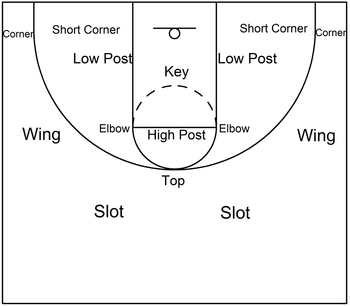
When executing a youth basketball offense, there are different spots on the basketball court that each player could fill based on the offensive formation. These spots are known as the top, the slots, the wings, the corners, the low post areas, and the high post areas.
The slots are also known as the lane line extended, the wings are also referred to as the free throw line extended areas, the high posts are also called the elbows, and the space between the low post areas and the corners are also known as the short corners.
Furthermore, the area between the low posts and high posts which also contains the dotted lines and the basket itself is referred to as either the key, the paint, or the free throw lane.
What are general principles to consider for youth basketball offense
Good spacing
When executing youth basketball offense, the players should try to be spaced apart about 12 to 15 feet. Essentially, if each player gets positioned near one of the court spots mentioned in the previous section, then this is representative of good spacing.
For example, if the point guard or primary ball handler is at the top, two players on each of the wings, and two players are in each of the corners or near the low post blocks, then the players have achieved good spacing.
Conversely, as another example, if the point guard or primary ball handler is at the top but two players are near the right side wing, then this is representative of bad spacing.
It is important for the players to have good spacing because it would be easier to execute actions such as screening or cutting and it will make it more difficult for one of the defenders to cover two offensive players in a sort of pseudo-zone defense.
Ball and player movement
With youth basketball offense, it is essential for the players to pass the ball to other teammates, primarily via ball reversal whenever necessary. This ball movement action will cause the defense to shift and potentially breakdown which would be beneficial for the offensive team.
Furthermore, it is of equal importance that the youth players do not just stand in place after passing to a teammate. Instead, the players should execute a basketball cut, particularly towards the basket when necessary or set a screen for a teammate.
If the youth basketball players are able to understand the basic concepts of ball movement and player movement, then this could lead to offensive scoring opportunities.
Good shot selection
Another benefit of ball and player movement is that it could lead to good shot selection, which are high percentage shots that players can make. If youth basketball players are able to take and make capable shots, then this could also boost their confidence and help them to continue developing their basketball skill sets.
What are brief explanations of the types of formations for youth basketball offense
The 3 out 2 in formation features three perimeter players and two interior players near the low post blocks. Additionally, this formation is also sometimes referred to as a 1-2-2 alignment because it contains one player at the top, two players on the wings, and two players near the low post blocks.
The 4 out 1 in formation features four perimeter players and one interior player. Of the four perimeter players, two are typically positioned near the slots while the other two are usually positioned near the wings or corners. The interior player is typically positioned near the low post or high post.
The 5 out formation includes five perimeter players positioned near the top, the wings, and the corners.
The Box formation features one player at the top, two players near the high posts, and two players near the low post. Also, the four players near the high and low posts form the shape of a box, hence its name.
What is an example of a basic continuity offense for youth basketball
Basic Screen Away Continuity – Part 1
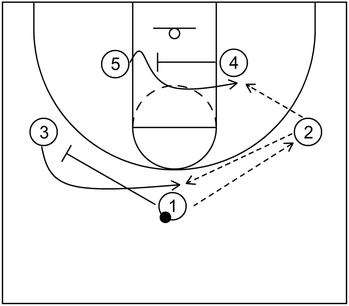
This is an example of a basic continuity pattern that includes a simple pass and screen away action which could lead to scoring opportunities near the perimeter or near the basket. To start, 2 receives the ball from 1 and afterwards, 3 cuts to the top via the screen away action set by 1.
At the same time, 5 cuts to the right side low post block via the cross screen set by 4. Following that, 5 could receive the ball from 2 and score near the rim.
Also, as another option, 3 could receive the ball from 2 and take the open jump shot as well. However, if 3 receives the ball but does not take the shot, then the continuity could begin and the same action gets executed on the other side of the floor.
Basic Screen Away Continuity – Part 2
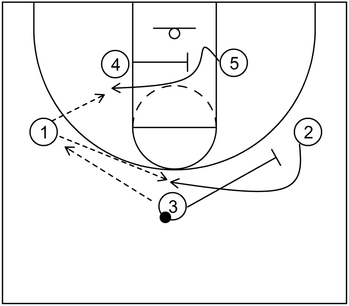
1 receives the ball from 3 and then 2 cuts to the top via the screen away action by 3. At the same time, 5 cuts to the left side low post block via the cross screen set by 4.
From there, 5 could receive the ball from 1 and score near the basket. Also, as an alternative option, 2 could receive the ball from 1 and take the open jump shot.
What are examples of motion offense for youth basketball
3 Out 2 In – Part 1
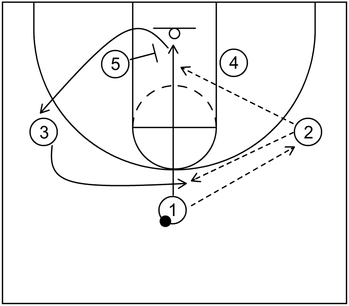
This is an example of a 3 out 2 in motion offense set that involves passing, cutting, screening, as well as a continuity pattern.
This particular set could be useful for youth basketball teams with at least two lost post players that are good screeners.
To begin, 2 receives the ball from 1 and afterwards, 1 cuts to the basket. Following that, 1 could receive the ball from 2 and then score at the rim. This particular action is also known as a pass and cut or a give and go.
Next, if 1 is not open to receive the ball, then 3 cuts to the top while 1 fills the left side wing via the pin down screen set by 5. From there, 3 receives the ball from 2 and after that, the action could be executed again as a continuity pattern.
3 Out 2 In – Part 2

1 receives the ball from 3 and afterwards, 3 cuts to the basket. Afterwards, 3 could receive the ball from 1 and score at the rim. If 3 is not open, then 3 cuts to the right side wing via a pin down screen set by 4.
At the same time, 2 cuts to the top and could receive the ball from 1. Following that, the continuity would run again until the players attempt a shot.
4 Out 1 In – Part 1

This is an example of a 4 out 1 in motion offense set that includes a flex screen which could be used to create scoring opportunities near the basket. To start, 4 receives the ball from 1 and then 3 receives the ball from 4.
Next, as that occurs, 2 cuts to the basket via the flex screen set by 5, receives the ball from 3, and scores near the basket. If 2 does not receive the ball, then 2 continues the cut to the right side low post while 5 fills the left side wing area.
4 Out 1 In – Part 2
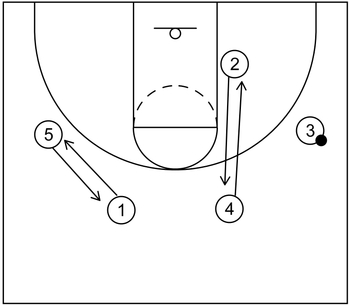
From this point, the motion offense will shift into a continuity pattern but first the players without the ball will exchange spots.
Therefore, 2 cuts to the right slot while 4 moves down to the right side low post. At the same time, 1 cuts to the left side wing area while 5 cuts to the left slot area.
4 Out 1 In – Part 3

Next, 2 receives the ball from 3 and then 5 receives the ball from 2. Also, 1 receives the ball from 5 and as that occurs, 3 cuts to the basket via the flex screen set by 4. Following that, 3 receives the ball from 1 and scores near the rim.
5 Out – Part 1

This is an example of a 5 out motion offense set that includes passing, cutting, and filling empty spots on the court.
To start, 2 receives the ball from 1 and after that, 1 cuts to the basket. Also, at the same time as 1 cuts to the rim, 3 cuts to the top and 5 fills the left side wing area.
If 1 is open, then 1 could receive the ball from 2 and score near the rim. However, if 1 is not open, then 1 could cut out to the left side corner.
5 Out – Part 2
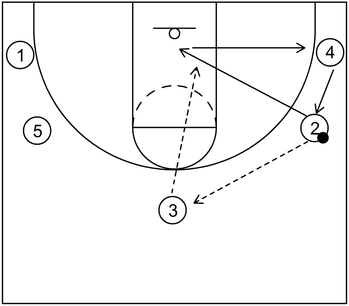
Next, 3 receives the ball from 2 and immediately after that, 2 cuts to the basket. At the same time, 4 fills the right side wing previously occupied by 2.
If 2 is open, then 2 could receive the ball from 3 and score at the rim. If 2 is not open, then 2 could cut out towards the right side corner.
5 Out – Part 3

At this point, the offense could flow into the continuity pattern so the action gets executed again on the opposite side of the floor. 5 receives the ball from 3 and after that, 3 cuts to the basket. At the same time, 2 cuts to the top and 4 fills the right side wing.
If 3 is open, then 3 could receive the ball from 5 and score at the rim. If 3 is not open, then 3 could continue the cut out towards the right side corner.
What is an example of zone offense for youth basketball
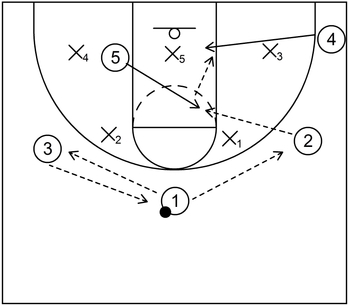
This is an example of a zone offense set play that includes a flash cut and straight cut to the basket for scoring opportunities.
3 receives the ball from 1 and quickly reverses it back to 1. The main objective of this ball reversal action is to shift the defense.
Next, 2 receives the ball from 1 and as that happens, 5 flashes into the middle of the zone. Also, at the same time, 4 cuts straight to the basket from the right side corner.
Following that, 5 could take the mid-range jump shot if open or 4 could receive the ball from 5 and score near the basket.
What is an example of a quick hitter for youth basketball offense
Part 1

This is an example of a quick hitter for youth basketball offense that involves screens to create scoring opportunities near the perimeter or near the basket.
To begin, the players set up in a box formation with 1 at the top, 4 and 5 near the high posts, and 2 and 3 near the low posts.
Next, 2 and 3 cut to the left side and right side wings via the down screens of 4 and 5. For this example, 2 receives the ball from 1.
However, 3 could receive the ball as an alternative option. Furthermore, 4 and 5 fill and replace at the low post areas after setting the down screens.
Part 2
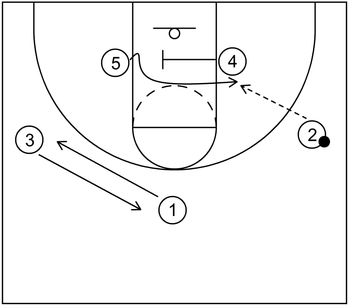
Next, 2 could take the jump shot if open after receiving the ball from 1. If 2 does not take the jump shot, then 5 could cut to the right side low post block via the cross screen set by 4.
Following that, 5 could receive the ball from 2 and score near the basket. Also, 1 and 3 could exchange spots on the court to occupy the defense.
What is an example of a backdoor cut play for youth basketball offense
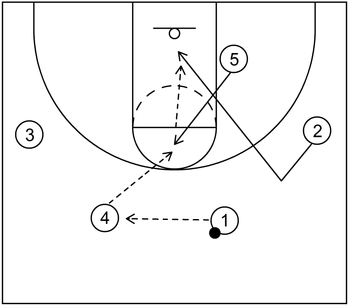
This is an example of a simple backdoor cut for youth basketball offense. To start, 4 receives the ball from 1 and as that occurs, 5 flashes to the high post area near center of the free throw line.
Next, 5 receives the ball from 4 and then 2 quickly executes a backdoor cut towards the rim. Following that, 2 receives the ball from 5 and quickly scores at the basket.
What is an example of a pick and roll play for youth basketball offense
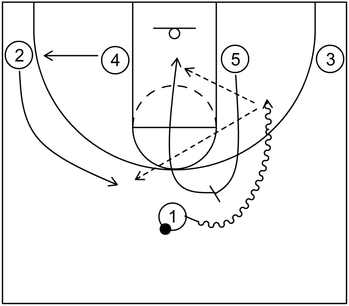
This is an example of a pick and roll play for youth basketball offense which begins with a 1-4 low formation. To start, 1 dribbles toward the basket near the right side of the court by way of the on-ball screen set by 5.
Next, 5 rolls to the basket and at the same time, 4 pops out to the corner while 2 lifts up near the left slot area. From there, 5 could receive the ball and score near the rim or 2 could receive the ball and take the jump shot if open.
What are examples of out of bounds plays for youth basketball offense
Baseline Out of Bounds
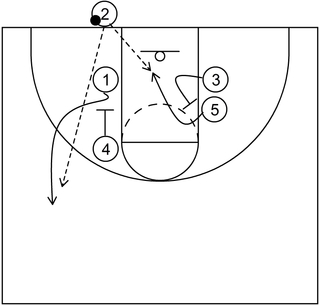
This is an example of a very simple baseline out of bounds play that can create a scoring opportunity near the basket. To start, 5 cuts into the lane via the back screen set by 3 and at the same time, 1 cuts to the perimeter via the down screen set by 4.
Following that, 5 could receive the ball from 2 and score near the basket. Also, 1 could receive the ball as an alternative option and then initiate other offensive sets from there.
Sideline Out of Bounds
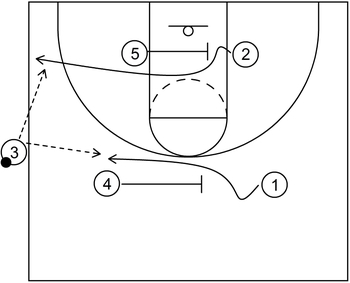
This is an example of a very basic sideline out of bonds play that can create a scoring opportunity near the perimeter. To start, 2 cuts to the left side corner via the cross screen set by 5. Also, at the same time, 1 cuts toward the left slot area via the screen set by 4.
Following that, 2 could receive the ball from 3 and take the jump shot if open. Also, as a secondary option, 1 could receive the ball from 3 and take the open jump shot or initiate other offensive sets.
What is an example of a press breaker for youth basketball offense

This is an example of a simple press breaker for youth basketball implemented against a 1-2-1-1 full court press. To begin, 1 cuts to the ball side via the screen set by 2 and then afterwards, 1 receives the ball from 3.
As that occurs, 4 cuts up the lane, 5 cuts up toward the middle of the floor, and 2 cuts down the opposite sideline after setting the screen. Next, 4 could receive the ball from 1.
After that, 5 could receive the ball from 4 and then 2 could receive the ball from 5. Following that, 2 should try to get downhill and dribble ahead of X5 or take the open mid-range jump shot if X5 retreats to protect the basket.
What are positional concepts to consider for youth basketball offense
The standard basketball positions are typically known as the point guard, shooting guard, small forward, power forward, and center.
The point guard is usually the team’s primary ball handler and offensive initiator. The shooting guard is usually the team’s best shooter/scorer. The small forward is typically the team’s secondary shooter/scorer and this player could also have rebounding capabilities.
The power forward is usually one of the team’s tallest players and is generally good at gathering rebounds and scoring points, either near the basket, from the mid-range, or from three-point territory.
The center is typically the team’s tallest player, best rebounder and low post scorer. Additionally, the center is usually the team’s best rim protector defensively.
In terms of youth basketball offense, particularly with younger players, the coaching staff could either assign certain positions to each player or use more of a position-less approach.
If the coaching staff does decide to assign positions, then each player should have that assigned position based on their respective strengths.
For example, if one of the youth players is great at dribbling the ball, especially with either hand, then that player could be assigned the point guard position.
Also, if the coaching staff is not sure which players are good at what skill sets, then the coaches could either allow the players to play against each other in a scrimmage or the coaches could have the players run different types of drills to determine the players’ abilities.
This could also help the coaches to learn which skills need to be developed as well. However, it should also be noted that the coaching staff should not pigeonhole the players into certain types of roles, especially on offense, based solely on the players’ position.
For example, if the coaching staff assigns a certain player as the team’s center, then that player does not necessarily only have to score around the basket if they can also score near the perimeter.
Similarly, if the coaches designate a certain player as the team’s point guard, then that player should not only have the role of initiating the team’s offense and passing to other teammates if that player has the ability to either shoot near the perimeter or drive to the basket.
Also, if one or more players can play multiple positions, then the coaching staff could utilize that as a strategy too.
For example, if one of the team’s guards has the ability to dribble or shoot, then that player could get assigned either role depending on the situation or the roles of the other teammates on the court at that time.
Furthermore, if the coaching staff implements certain types of motion offense such as 5 out, then the players could swap positions during the flow of the offensive sequence.
In other words, the players would be playing in more of a position-less type of system as mentioned earlier. In any case, it is important for the coaches to allow the players to develop different types of skills that works best for each player.
What are concepts of pivoting to consider for youth basketball offense
A pivot foot is the first foot that touches the floor upon receiving and controlling the basketball. However, if both feet were already touching the floor, then either foot could become the pivot foot.
In either case, once a pivot foot gets established, it cannot be lifted from the floor and re-established again without dribbling the basketball, passing to another teammate, or shooting a jump shot.
If a player does lift the pivot foot and then puts it back down again without dribbling, passing, or shooting, then that would be considered a traveling violation.
In terms of youth basketball offense, if the players are able to grasp the basic concepts of pivoting, then this knowledge could be used to cut down on turnovers, particularly from traveling violations.
Additionally, by learning how to use the pivot foot, youth players would be able to turn their bodies away from the defender while protecting the basketball, particularly during a pressure defensive situation.
This, in turn could make it more difficult for the defensive team to get steals or takeaways, which also leads to reduced turnovers for the offensive team.
Furthermore, over time, players could learn to use the pivot foot to execute certain types of basketball moves such as a no-dribble jab step (with the non-pivot foot) which could be used to fake in one direction and then dribble in the other direction.
Also, the players could use that same no-dribble jab step to simply create space for a possible jump shot.
To get a general feel for pivoting, youth players could start by standing on both feet as normal about shoulder width apart. Afterwards, slightly bend the knees with the back straight and then lift one foot from the floor.
This is now the non-pivot foot. Next, the players could begin to slowly turn the other foot, which is now the pivot foot, until they make a full circle.
Also, it should be noted that players do not have to always keep the non-pivot foot from touching the floor while turning the pivot foot. Instead, the players could turn the pivot foot little by little.
To analogize this type of movement with the pivot foot, it could be something like 90 degree angles or something like an analog clock where the pivoting starts at 12 o’ clock, then turns to 3, then to 6, then to 9, and finally back to 12.
This method could hopefully help youth players get a basic feel for using the pivot foot and possibly assist players with foot balance as well.
Also, it should be mentioned that when pivoting, players should be on the balls of the foot and not standing flat footed as this could make pivoting more difficult, less efficient, and it could also potentially lead to them becoming unbalanced, especially if they attempt to pivot on the heels of the feet.
Additionally, while pivoting, players cannot slide the pivot foot from one spot on the floor to another spot. In that case, although the player may not have lifted the pivot foot from the floor before dribbling, passing, or shooting, this is still considered illegal movement and is therefore, a traveling violation.
Related: Forward Pivot Drill – YouTube
What are concepts of shooting to consider for youth basketball offense
Shooting is one of the fundamental skills within the game of basketball. If players cannot shoot the basketball, then it most likely would be challenging to score points consistently so it is very important for players to always find time to practice shooting.
Basic Shooting Mechanics
In terms of basic shooting mechanics, youth players should start close to the basket as opposed to around the perimeter. Also, the youngest players should start practicing shooting mechanics on lower rims if possible.
Next, players should place the dominant hand (i.e the shooting hand) behind the basketball with the non-dominant hand (i.e. the guide hand) near the side of the ball.
Also, players’ thumbs should make a shape similar to an L or upside-down T while holding the ball. Additionally, players should spread the fingers apart at a comfortable distance and grip the ball with the pads of the fingers.
Players should not hold the ball in the palm while trying to shoot as this would most certainly lead to inconsistent and/or inaccurate shot percentages.
Next, players should place the ball near the hip area, with the feet about shoulder width apart and their eyes on the rim.
Players could also have the dominant foot slightly in front of the non-dominant foot as long as the players have both feet towards the rim.
At the same time, players should tuck in the shooting elbow so that it is aligned with the center of the rim. Following that, players should bend the knees, keep the back straight, and at the same time, place the ball slightly above the forehead with eyes still on the rim.
Next, players could jump in the air, release the ball above the rim, snap the wrists, and follow through with an extended elbow towards the basket.
It should also be noted that players should execute shot attempts with one fluid down-and-up motion as opposed to multiple movements which could lead to inconsistent shots.
Also, as for jumping in the air, players could take a small hop, also known as a set shot, or a larger jump. It really depends on what feels comfortable for the player.
Furthermore, on the jump action, players could also jump a little bit forward while shooting as long as their feet are still towards the rim. Again, it depends on what is comfortable for the player.
Additionally, as for shooting free throws, players do not necessarily have to jump in the air. However, they should still use the down-up fluid motion while rising up on the balls of the feet when shooting. This particular movement with the feet is also known as plantar flexion in medical terms.
Related: Fundamentals of Shooting – YouTube
What are types of passes to consider for youth basketball offense
The fundamental passes for youth basketball players include the chest pass, the bounce pass, and the overhead pass.
Chest Pass
The chest pass is the most common pass in basketball and it is usually the easiest one for young players to execute. This type of pass could be used in almost any situation provided the target of the pass (i.e. another teammate) is open to receive it.
These are the typical steps to execute the chest pass :
First, the player grips the ball near the chest area with both hands on the side of the ball. Smaller players such as a 6 or 7 year old could also place the non-dominant hand on top of the ball for better grip and control, if necessary.
Second, the player takes one step toward the target, usually with the dominant foot. Third, the player extends the arms, snaps the wrists, and releases the ball towards the target’s chest area.
Fourth, the player follows through with the fingers spread towards the target and the thumbs pointing in a downward direction.
Bounce Pass
The bounce pass is another common pass in basketball. However, it might take youth players, particularly the very young ones, more time to efficiently execute this type of pass when compared to the common chest pass.
This type of pass is typically good for situations in which a target is open to receive the ball but it is too risky to throw the standard chest pass.
As an example scenario, a player with the ball would like to throw a chest pass to an open teammate. However, that player’s defender has their hands high in the passing lanes which means it is too risky to throw the chest pass because that could lead to a deflection and/or turnover.
Therefore, the player with the ball decides to throw the bounce pass below the hands of the defender to the open teammate with minimal or no risk that could result in a deflection or turnover.
These are the typical steps to execute the bounce pass :
First, the player grips the ball near the chest/stomach area with both hands on the side of the ball. Smaller players such as a 6 or 7 year old could also place the non-dominant hand on top of the ball for better grip and control, if necessary.
Second, the player takes one step toward the target, usually with the dominant foot. Third, the player extends the arms, snaps the wrists, and releases the ball with enough strength towards a spot on the floor between themselves and the target.
Fourth, the player follows through with the fingers spread towards the target and the thumbs pointing in a downward direction.
If the player bounces the ball with the proper amount of strength, then the ball should bounce up towards the target’s chest/stomach area. However, if the player bounces the ball on the floor without enough strength, then the ball will most likely be too low and the target would have to bend down to receive it.
Also, if the player bounces the ball on the floor with too much strength, then the ball will most likely be too high and the target might have to reach higher than the chest/stomach area to receive it.
Therefore, the player should consider practicing the bounce pass a number of times to determine the right amount of strength needed for the ball to bounce up towards the target’s chest/stomach area.
Overhead Pass
The overhead pass is typically used to move the ball faster than the standard chest pass or bounce pass. Additionally, the overhead pass is generally executed when the passer is far away from the target.
For example, in the half court setting, the overhead pass could be used to quickly skip the ball from one side of the floor to the opposite side.
Another example could be when a player gets a defensive rebound and then executes the overhead pass towards a target further down the court such as with a fast break situation.
Also, the overhead pass could be used in certain instances when the passer is not too far from the target but the defense executes a type of defensive pressure that makes it more difficult to execute the chest pass or bounce pass.
For example, if the defender pressures up on the passer with their hands covering the passer’s chest/stomach area. In that case, the passer could simply execute the overhead pass over the head (no pun intended) of the defender to the target.
These are the typical steps to execute the overhead pass :
First, the player grips the ball slightly over (or above) the head with both hands on the side of the ball. Also, the player should not place the ball directly behind the head or neck area when attempting the overhead pass as a defender could knock the ball loose and cause a turnover. Furthermore, placing the ball too far behind the head/neck could slow down the velocity of the ball which would make the overhead pass ineffective at best.
Second, the player takes one step toward the target, usually with the dominant foot. Third, the player extends the arms, snaps the wrists, and releases the ball towards the direction of the target.
This could be directly to the target’s chest area or ahead of the target such as a situation where the target could be cutting towards the basket. Fourth, the player follows through with the fingers and thumbs pointing downward.
Related: Bounce, Chest, and Overhead Pass – YouTube
What are types of cuts to consider for youth basketball offense
The fundamental cuts to consider for youth basketball offense would generally be the straight cut, the backdoor cut, the v-cut, and the fill cut.
Also, these cuts are typically used with continuity/motion offenses so they could get executed multiple times while creating scoring opportunities for the players.
The straight cut occurs when the player cuts straight to the basket as the name implies. The fill cut occurs when the player cuts to an empty space on the floor. In other words, they would be filling a space that was unoccupied by another teammate.
The backdoor cut occurs when the player cuts to the basket, usually as a counter to being denied the ball by the defense.
Also, the V-cut occurs when the player cuts toward the basket from the perimeter but then pops back out in the shape of a V on the court, and then receives the ball from a teammate.
What are types of screens to consider for youth basketball offense
The primary types of screens to consider for youth basketball offense would be the back screen, the cross screen, the down screen, and the on-ball screen.
The back screen occurs when an offensive player sets a screen for a teammate behind that teammate’s defender.
The cross screen occurs when an offensive player cuts across the lane near the low post to set a screen for a teammate. Additionally, a player could set a screen for a teammate across the high post as well.
The down screen occurs when an offensive player turns toward the baseline to set a screen for a teammate, who would then cut towards the perimeter.
The on-ball screen occurs when an offensive player sets a screen for a teammate with the ball.
Afterwards, the player that set the screen would either roll to the basket, also known as pick and roll, or pop to an area near the perimeter, also called pick and pop.
What are general concepts of dribbling to consider for youth basketball offense
When dribbling the basketball, players should control and dribble the ball with one hand at a time. If players attempt to dribble with both hands at the same time, this is considered a double dribble violation. Also, players should dribble with the pads of the fingers and not with the palm of the hand.
Additionally, players should try to stay low and protect the ball, particularly when the defense is executing on-ball pressure. Furthermore, players should try to keep their eyes up to see the court and the other players on the court.
If players are always looking down at the ball, then they will not be able to see the defense who could potentially steal the ball as well as teammates who could be open for scoring opportunities.
Also, players should learn how to dribble efficiently with the dominant hand as well as the non-dominant hand.
If players are only proficient with the dominant hand, then defenders will most likely try to force the player to use the weaker non-dominant hand which could lead to ineffective dribbling and/or turnovers.
Related: Fundamentals of Dribbling – YouTube
What are types of dribble moves to consider for youth basketball offense
The fundamental dribble moves for youth basketball offense include the crossover dribble, the between-the-legs dribble, and the behind the back dribble.
Crossover Dribble
The crossover dribble occurs when the player dribbles the ball from one hand to the opposite hand. Also, in the process of switching the ball to the opposite hand, the player will typically step in one direction before executing the crossover.
For example, the player initially dribbles with the right hand, takes one step towards the defender with the right foot (as if to dribble in that direction), then bounces the ball on the floor to the left hand while moving in that same direction towards the left.
A very basic drill to learn the crossover dribble is to stand in one spot with the feet shoulder width apart, knees slightly bent, and the back straight.
Next, the player simply crosses the ball over from one hand to the other. The player should dribble from one hand, to the floor, and then to the opposite hand in the shape of a V.
Between-The-Legs Dribble
Between the legs dribble occurs when the player dribbles the ball with one hand, then bounces it on the floor between the legs, and afterwards, catches the ball with the opposite hand.
A simple drill to learn the between-the-legs dribble is to place the feet slightly beyond shoulder width apart, bend the knees, and straighten the back.
Next, the player dribbles the ball on the floor between the legs and catches it with the opposite hand. Afterwards, the player could center the ball back in front and repeat the same move over and over.
Another variation of the drill is to dribble the ball between the legs, catch it, but afterwards, dribble the ball back between the legs with the opposite hand.
With this variation, the player dribbles the ball continuously without bringing the ball back to the front to start over. This is also a great way to strengthen the wrists and develop finger pad control.
Behind the Back Dribble
Behind the back dribble occurs when the player dribbles the ball with one hand behind the back, bounces it on the floor, and then catches it with the opposite hand.
With the behind the back dribble, the player should dribble from one hand to the other in the shape of a V, similar to the crossover dribble.
One basic progression for learning the behind the back dribble is for the player to sit in a chair and dribble under the legs without looking at the ball.
While this is not an actual behind the back dribble, it is a very good way of getting a feel for the ball when it is not in front of the player.
What are examples of team passing drills for youth basketball offense
The drills below are geared toward beginners and they focus on developing passing, catching, and hand/eye coordination for youth basketball players.
For these drills, the youth players could practice the fundamental passes such as the chest pass, bounce pass, and overhead pass.
Around the World 1
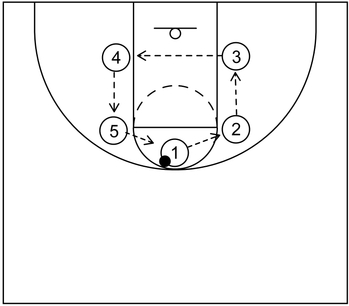
This is an example of a team passing drill in which the players will form a box-like shape around the free throw lane area. 1 starts slightly above the free throw line.
2 starts near the right side high post. 3 starts near the right side low post area. 4 starts near the left side low post. Lastly, 5 starts near the left side high post area.
To begin the drill, 2 receives the ball from 1 and quickly passes the ball to 3. After that, 4 receives the ball from 3 and then quickly passes it to 5.
Following that, 1 receives the ball from 5 and the drill continues on from there for a certain amount of time or a specific amount of pass attempts based on the preference of the coaching staff.
Around the World 2
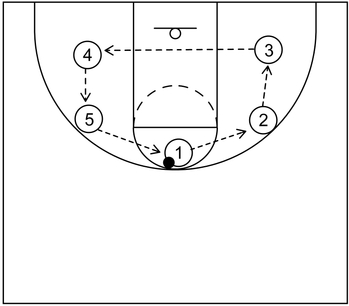
This is another example of a team passing drill similar to the previous one. However, this time, the players are a little more spread apart for a slightly increased challenge.
To begin, 2 receives the ball from 1 and then quickly passes it to 3. Next, 4 receives the ball from 3 and then quickly passes it to 5. After that, 1 receives the ball from 5 and the drill continues from there for a certain amount of pass attempts or minutes.
Around the Top
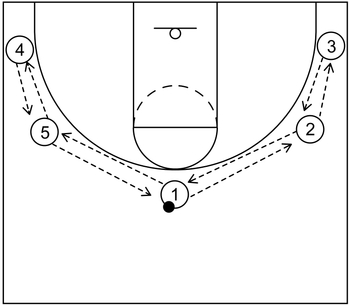
This is an example of a team passing drill in which the players are spaced even further apart beyond the three-point arc. This drill also emphasizes ball movement via ball reversal, which could be useful against man to man or zone defense.
The drill is set up with 1 at the top, 2 near the right side wing, 3 near the right side corner, 4 near the left side corner, and 5 near the left side wing. To start, 2 receives the ball from 1 and then quickly passes it to 3.
After that, 2 receives the ball from 3 and then reverses the ball to 1. Next, 5 receives the ball from 1 and then passes it to 4.
Then, 5 receives the ball from 4 and quickly reverses it back to 1. From there, the drill can continue for a certain amount of time and/or pass attempts between the players.
Star Passing 1
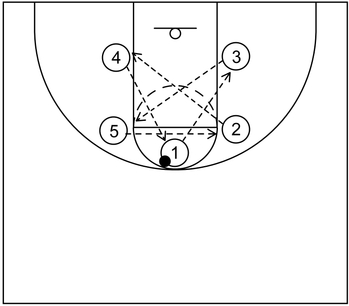
This is an example of another type of team passing drill that emphasizes passing, catching, and hand/eye coordination.
The drill is set up with 1 slightly above the free throw line, 2 near the high post, 3 near the right side low post, 4 near the left side low post, and 5 near the left side high post.
To begin, 3 receives the ball from 1 and then quickly passes it to 5. Next, 2 receives the ball from 5 and then quickly passes it to 4.
Following that, 1 receives the ball from 4 and from there, the drill could continue for a certain amount of time and/or pass attempts.
Star Passing 2
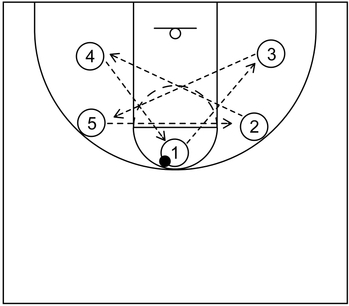
This is an example of a team passing drill which is similar to the previous one. However, this time, the players are spread even further apart. To begin, 3 receives the ball from 1 and then quickly passes it to 5.
Next, 2 receives the ball from 5 and then quickly passes it to 4. Following that, 1 receives the ball from 4 and from there, the drill could continue for a certain amount of time and/or pass attempts.
Partner Passing 1
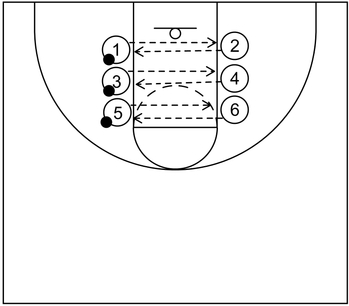
This is an example of a team passing drill in which one player will partner up with another teammate to work on developing passing skill sets.
For the set up, players will line up on opposites side of the free throw lane and face their teammate which is directly across from them.
To begin the drill, 1, 3, and 5 each start with a basketball. From there, those players could throw a chest pass, bounce pass, or overhead pass to the respective partner. For example, if 1 throws a chest pass to 2, then after that, 2 could throw a chest pass to 1.
Also, one partner could throw a certain type of pass while the other partner throws another type of pass. For example, if 3 throws a bounce pass to 4, then afterwards, 4 could throw a chest pass or an overhead pass back to 3.
Additionally, it should be noted that while this drill only uses six players, it is definitely possible to add more players as available or needed.
Partner Passing 2

This is another variation of the previous drill. However, this time, the players will move down the court while executing the fundamental passes to each other.
For the set up, 1 starts near the right corner, 2 begins near the right low post block, 3 starts near the left side low post block, and 4 begins near the left side corner.
Next, the players should slide their feet towards the half court or down towards the opposite baseline for an added challenge while executing fundamental passes with their partner.